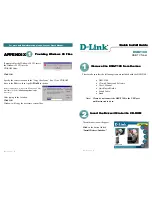
6
T1 is wound on a ferrite toroidal core (gray, FT37-43; may have an orange dot). Cut two 10" (25 cm)
lengths of #26 enamel wire, one red and one green. Twist the two wires together, crossing over each other
about 3 to 4 times per inch (1-2 times per cm). Then wind the twisted wires onto the core as shown below,
using 10 turns. Each pass through the core counts as one turn, and turns spacing should closely resemble
the illustration.
i
The wires labeled (1) and (3) should originate from below the core, and wires (2) and (4)
from above it, as shown below. This will ensure that the transformer has the correct phasing.
3 (RED )
1 (GRN)
2 (GRN)
4 (RED )
Trim the leads of T1 to about 1/2" (12 mm) long. Completely remove the insulation from T1's leads
up to the edge of the core, using a solder pot or hot soldering iron tip. Do not attempt to burn off the
insulation using a match or lighter, as the flame may fuse the pairs of wire together, causing them to
become shorted. Another way to remove the insulation is to use fine sand paper.
Tin T1's leads with solder. If the leads do not tin easily, the insulation may not be fully removed.
Using an ohmmeter, measure between the red and green wires to make sure that they're not shorted.
Install T1 as indicated by its PC board outline near the right end of the board. Insert the leads into the
numbered holes as shown by the drawing of T1. Pull the leads taut on the bottom of the board. Before
soldering, make sure that the entire portion of exposed lead is properly tinned.
Cut a 1-1/8" (2.9 cm) length of insulated, solid-conductor hookup wire. Remove 1/4" (6 mm) of
insulation from each end. This jumper will form the 1-turn link winding of T1.
Insert this wire through the center of T1 and into the pad labeled
5
. Bend the wire down to the left and
insert the other end into pad
6
. Pull the leads of the wire taut on the bottom of the board, then solder.


































